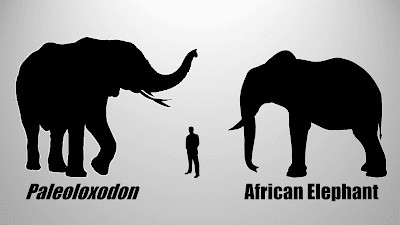Neandertals: Mighty Hunters before the Lord!
New research last week documents a startling record of Neandertal hunting. Now we've known for some time that Neandertals were good hunters and that they could take down big game. This new work based on an ancient lake deposit from Germany where the remains of a couple dozen straight-tusked elephants (Paleoloxodon) were found. They were originally excavated in the 1980s and 1990s during rescue excavations ahead of mining operations. There were plenty of stone tools found with them, and they've long been known to be an odd deposit. The remains were largely from adult bull elephants, which in African elephants are known to be kind of loners. There was a dearth of young or female animals. The way they were deposited was also peculiar, with a few sites concentrating just tusks. Not surprisingly, the concentration of stone tools matched that of the elephant bones.
The new research by Gaudzinski-Windheuser and colleagues examined the bones for cut marks, and they found a remarkable record of the butchering of these animals. For example, cut marks on the neck vertebrae and skull indicated that the head was removed from the body, likely for accessing the brain. Likewise, cut marks on the jaw revealed that the face was also stripped of meat. Muscles running along the spine were also removed. They even found cut marks on the inside of the ribs, indicating that the animals' organs were removed in the butchery process. The ends of the long limb bones also bore lots of parallel cut marks, indicating that they were removing the limbs as well. In contrast, the gnawing marks of predators on the bones were comparatively fewer, and often in surprising places, such as the exposed ends of long bones, indicating that the scavengers came in after the animal had already been butchered.
Now we've known for a long time that Native Americans hunted mammoths and would often stash their carcasses in ponds, presumably as a preservative to keep the meat cool. In 2015, such a mammoth (the Bristle mammoth) was discovered about a half hour drive from my childhood home, so the idea that people could hunt really big game like this was not surprising to me. But Neandertals are different. They're quite distinct from Homo sapiens, and theistic evolutionists and old earth creationists tend to view them as not human or not fully human. Young age creationists tend to see the evidence differently and include them as human for a variety of reasons. They made sophisticated tools and controlled fire. They cared for their wounded and buried their dead. They were able to get into to remarkably difficult locations, such as deep in the dark zone of caves. We even have various evidences of Neandertal decor and art, including using eagle talons and shalls for decoration and exploiting ochre for coloring. For a young age creationist like me, that sure sounds like the work of people not animals. They're different people for sure, but people nonetheless.
 |
| Me and the Bristle Mammoth at the University of Michigan in 2016. |
Now back to our butchered elephants (which are bigger than mammoths). First, imagine the number of people it would take to bring down an elephant. Imagine the coordination requited to do so. Maybe that's not impressive enough for you. Now think about the butchering of the animal, which in this case is extremely thorough. These Neandertals took almost every part of the animal, which would require hours of work. The researchers estimated it would take 25 Neandertals working 3-5 days to thoroughly butcher an elephant the way these elephants had been butchered. The result is literally tons of meat, enough to feed 350 Neandertals for a week. Or the Neandertals had methods of preserving the meat, possibly by smoking. Either way, that's some incredibly sophisticated behavior.
For me, this evidence just re-affirms that these people were people. No mere animal takes down an elephant and butchers it completely and is able to gather 350 close friends for a feast or starts a fire to smoke their newly-acquired tons of meat. And then they did this dozens of times over, all on the shore of that one little lake. Now I don't think Nimrod was a Neandertal (no reason to think so), but I think the appellation "mighty hunter before the Lord" applies to anyone who can take down an elephant multiple times.
But don't take my word for it. Check out the original research report for yourself.
Gaudzinski-Windheuser, S., L. Kindler, K. MacDonald, and W. Roebroeks. 2023. Hunting and processing of straight-tusked elephants 125.000 years ago: Implications for Neanderthal behavior. Science Advances 9:eadd8186.
Feedback? Email me at toddcharleswood [at] gmail [dot] com. If you enjoyed this article, please consider a contribution to Core Academy of Science. Thank you.
Have you read my book? You should check that out too!

